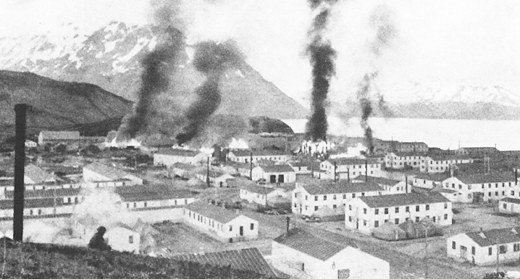• Describe the legacy of World War II for Alaska. What happened in Alaska after the war that is largely attributable to WWII? What are Alaskans living with today that is attributable to WWII?
Military/National Security:
| Whittier Military Tower |
The Alaska Territorial Guard, put into place in WWII, was incorporated into the Alaska National Guard. The ANG is common for both men and women from rural Native communities. ANG provides education and training opportunities. They have been called to assist during long periods of extreme cold and snow. They have also served in both Iraq and Afghanistan.
Infrastructure:
| Alaska Highway |
- Dock facilities
- Runways
- Housing
- Power stations
- Military bases: Some military bases that are no longer in use by the government are used by civilians.
| Quonset hut |
Political-economic:
Local economies where there were military bases did much better than those who did not have bases. After the war, Alaskans took civilian jobs on bases. The scope of operations is still significant in Alaska’s economy and population dynamics. Military men started to bring their families up to Alaska and this impacted schools, churches, and civic organizations. Others moved to Alaska because they were drawn to the adventure it has to offer, work and land under an Alaska homestead act.
 |
| Signing of the Alaska Statehood Act |
Socio-cultural:
 |
| Unalaskan Families |
The Native Civil Rights Movement started back in 1867. From that time up to WWII, Alaska Natives acted to assert their rights to traditional lands, access to resources, citizenship and voting rights. During WWII, the Natives served in the military, which they had hoped would demonstrate their loyalty to Alaska. Because of this action, they expected equal treatment and resolution to outstanding land issues. In 1945, with the help of Elizabeth and Roy Peratrovich, the Anti-Discrimination Act was introduced. This helped the Alaska Native Claims Settlement Act of 1971 to come about.
Environmental:
 |
| Former St. Lawrence Military Base |
In the Norton Sound region, bases were mostly built for communication operations. PCBs were used in transformers and other electrical equipment. PCBs entered the marine and freshwater environment affecting the fish and marine mammals, most of which Natives used for subsistence. The military has spent millions of dollars to help clean up what was left behind but there is still a lot to be done.
 |
| Military Waste |
| Eagle River Flats |
Examine Question:
Describe the major events in the Aleutian Campaign of World WarII.
 |
| Burning buildings at
Ft. Mears after first enemy attack on Dutch Harbor, 3 June 1942 |
This was the second time in U.S. history that American territory had been occupied by an invading army. Efforts to drive the Japanese out started immediately. Japanese reasoning for taking the islands was to have bases for long-range sea planes in order to detect American activity. They also believed that the islands would block any American attack on the Japanese islands. The U.S. believed that the Japanese took control in order to have a shorter distance to fly to bomb the aircraft plants and navy yards around Seattle.
| Japanese officers at the Aleutian Islands, circa 1942-1943 |
The U.S. effort to take back the islands started with bombing raids on the islands carried out by navy flying boats, or large seaplanes, and army air force bombers. The Japanese suffered a great loss. American submarines were attacking Japanese ships that were carrying arms and supplies to Attu and Kiska. They were attacking from the air and water at the same time.
| Massacre Bay, Attu, Aleutian Islands, 13 May 1943 |
 | |||
| Ready to move against Kiska in 1943 |
This site gives a very detailed account of what happened in the battle over the Aleutian Islands. The History Channel also has some really good videos to watch about the battle. I wasn't fully aware about this battle until I started researching it. It makes me proud as an American to see that we have always been a force to recon with. And to see the sacrifices made in order to keep this country free from invasion. It also saddens me to thing that the military would send in troops poorly equiped for the elements because they thought it would weigh them down. You would think they would have wanted them to be able to fully function during battle and not have to worry about how to keep warm.
Evaluation:
I liked reading all of this information and finding diferrent resources to help me answer the questions. It was interesting to learn how the actions of WWII affected life afterwords. I also learned a lot about the battle over the Aleutian Islands and how it came about and the impact it had on not only the military, but also the people of the islands and how their lives were changed.
Reviews:
I like reading Claire's blog. I had answered the same question but it is always nice to read what someone else has to say about the same issue. Nicely done Claire.
I like Lane's blog, there are very nice links and good pictures to aid in the answers.
I was very impressed with Heather's blog. It's very visually appealing and nicely arranged. She has a lot of resources and links and pictures. :)
No comments:
Post a Comment